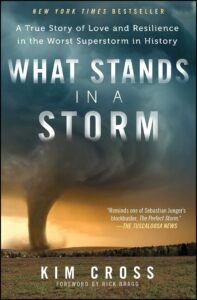by Kim Cross
 All great natural disaster stories have two things in common: good, accessible science and human drama.
All great natural disaster stories have two things in common: good, accessible science and human drama.
Kim Cross does both well in telling about the April 27, 2011, tornado that blasted through Tuscaloosa, on the worst day of the worst month of the record-breaking 2011 tornado season.
That season ended with the May 20, 2011, EF5 tornado that plowed through Joplin, MO. It was the single deadliest tornado reported since record-keeping began in the 1950s, killing 158 people and injuring more than 1,000.
The tornado Cross focuses on was not the strongest tornado of the day, but it hit one of the biggest population centers in Alabama. The monster was a multiple vortex, wedge tornado that drove through the southern and eastern parts of Tuscaloosa around 5:10 p.m. on April 27, 2011.
According to the National Weather Service, the tornado’s path was 80.7 miles long, 1.5 miles wide and had peak winds of around 190 mph. Forty-four people were killed in Tuscaloosa and 20 more in nearby Birmingham. More than 1,500 people were injured.
Human tragedies and miraculous survivals run throughout the book, but Cross focuses on Danielle Downs, her roommate Loryn Brown and her hometown friend and fellow student Will Stevens, who were sheltering in a house at 31 Beverly Heights, a low-lying area almost directly in the path of the tornado.
Danielle was two weeks away from graduating with a degree in social work. Loryn had been studying for an exam and Will planned to return to his hometown of Priceville and become a high school coach. Danielle’s beloved sister, Michelle, a student at Mississippi State University in Smithville, was due to be married a week after graduation. Danielle and Loryn’s roommate, Kelli Rumanek, was studying at the fortress-like University of Alabama library when the tornado came through.
During the course of the late afternoon and evening, all of the members of the Downs family – parents Terri and Ed, Danielle and Michelle – were under tornado watches. Michelle and Danielle had been texting up until moments before the tornado blasted through 31 Beverly Heights, uprooting a large, old tree that fell, bisecting the house and killing Danielle, Loryn and Will.
Tears will come to your eyes as Cross takes you through the uncertain hours until the families learn the terrible truth, attempt to find where the remains are, and go to identify the bodies at a makeshift morgue. And then there are the funerals . . .
Unlike Jack M. Bickham’s novel, Twister, Cross doesn’t go deeply into the mechanics of how superstorms and tornadoes develop. Bickham’s book, inspired by the April 3, 1974, outbreak of 148 tornadoes in 13 states and a Canadian province, is virtually a biography of a supercell.
Cross does write about the work of meteorologist James Spann at Birmingham’s ABC 33/48 television channel and other meteorologists and budding meteorologists who followed the storm and warned audiences about what was coming.
Spann in particular was committed to giving presentations to schools to teach students how to recognize storm dangers, get early warnings and take action. Cross also repeatedly touches on the Cold War Era warning systems often being used — and ignored — despite cell phones, text messaging, social media and other modern forms of communication.
Cross’s book is filled with anecdotes about the quirkiness of tornadoes. One town, Cordova, was hit first by an EF3 tornado and then, 12 hours, later by an EF4 tornado. A woman taking a cigarette break noticed cotton candy-like pink wisps floating through the air. She suddenly realized it was insulation from houses being torn apart by the second tornado on its way toward her.
In Tuscaloosa, a couple hid in a closet wrapped in each other’s arms. The tornado blew apart the house, ripping the girl from her boyfriend’s arms. She died. He lived.
As Cross writes, “Tornadoes are the Russian roulette of storms.” While most other natural disasters – hurricanes, earthquakes, floods – leave widespread damage, tornadoes are erratic. They may destroy one house and leave another standing.
The guilt of surviving when friends and family didn’t, adds to the trauma of the experience. Danielle’s other roommate, Kelli Rumanek, was almost catatonic with guilt that she survived in the university’s library while her roommates were killed. She struggled to get through the funerals that followed the disaster. She eventually became a social worker employed at a psychiatric hospital.
Well-written and deeply researched, What Stands in a Storm is a spell-binding read.
The Author: Kim Cross
Kim Cross is a contributing editor for Southern Living and an award-winning journalist and travel writer.
She holds a bachelor’s degree in journalism from the University of Alabama in Tuscaloosa and did a graduate fellowship there after a stint with Business 2.0, which covered the dot-com boom (and bust) in San Francisco.
She was a beat and spot news reporter for the New Orleans Times-Picayune, covering double-murders, hurricanes and local government.
She worked on staff at Southern Living and Cooking Light for near a decade before quitting to focus on this book.
Her work has appeared in Outside, Bicycling, Runner’s World, the Tampa Bay Times, The Birmingham News and USA Today.
She is an avid athlete who has competed nationally in water-skiing, sprint triathlon, off-road triathlon and twenty-four hour adventure racing. Currently, she focuses mostly on biking.
She lives in Birmingham with her husband and seven-year-old son.



